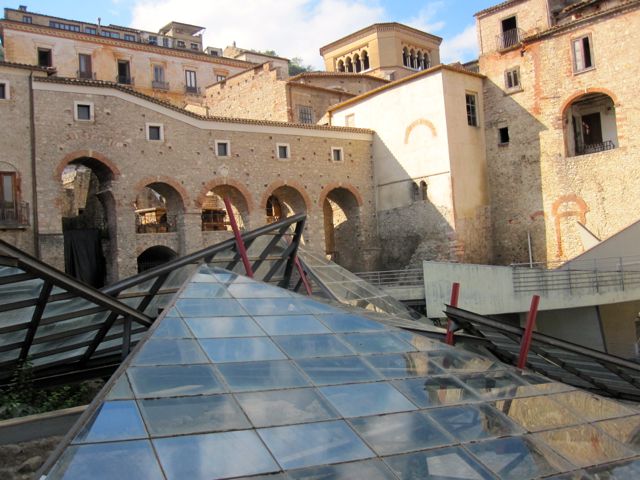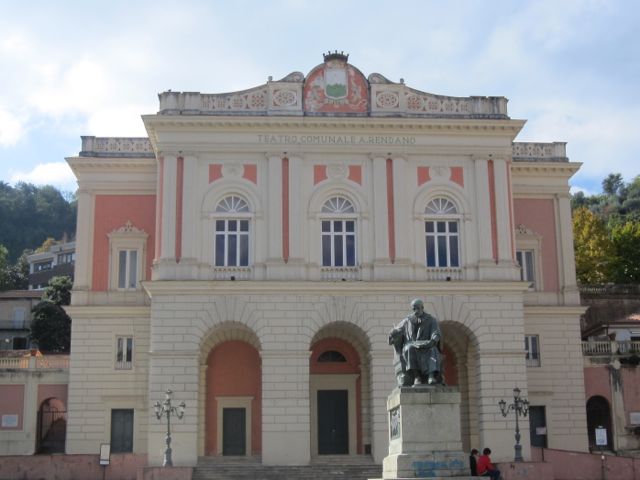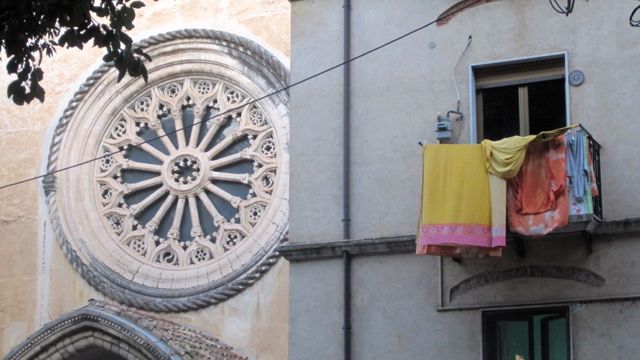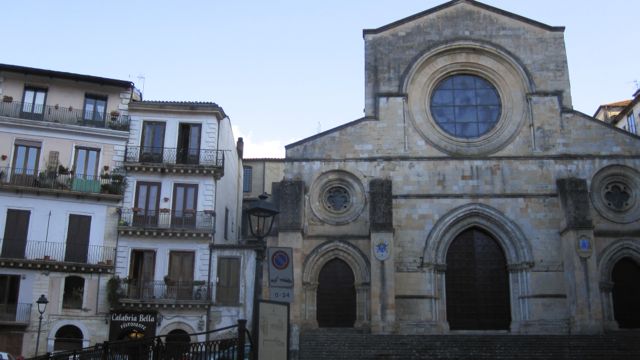THE CITY OF LAUNDRY
The first thing I noticed about Cosenza was the laundry. It was a beautiful day. Linens, T-shirts, jeans and intimates hung from windows like garland on a tree. This was a living city. “Matrimonial” sheets from king-sized beds (letti matrimoniali), folded lengthwise to fit along the wrought iron balconies, flapped against the antique edifices.
No one in Italy seems overly concerned with what their swinging laundry hits up against. This is the tradition and the invention of the dryer is not going to get in its way. I do know a handful of people whose homes are equipped with an asciugatrice, but who still prefer to give their biancheria (washing) the benefit of the sun’s rays and a sway in the fresh air. And truth be told, the dryer would certainly detract from this timeless vision of humanity.
COSENZA’S HISTORIC CENTER

Bruti and Roman archeological site uncovered by WW II bombs in Piazzetta Toscano with cathedral in background
The dangling laundry in the heart of the old town brushes up against some venerable walls, indeed. Founded by a local peoples called the Bruzi in the 4th century BC, the historic center of Cosenza sits on a hill at the meeting of two rivers. Archeological excavations show evidence of the city’s early existence, highlighting sites from the Bruzi and Roman periods. If Cosenza’s medieval walls could talk, or better said, if its rivers could speak, perhaps Alaric I, legendary King of the Visigoths who died there and was buried in the bed of the Busento River in 410 AD, might reveal the location of the great treasures sepulchered along with him.
Alas, I heard no such voice in my head as I strolled alongside the rivers and wandered through the town’s steep, narrow lanes. The heart of Cosenza is not for the weak – those Bruzi were a tough lot to have withstood the Greeks. One needs a set of strong leg muscles, and even today, finding that patch of sunlight amidst the shadows of the historic structures can be a challenge. In the words of George Gissing in his By the Ionian Sea (1901):
Cosenza has wonders and delights which tempt to day-long rambling. To call the town picturesque is to use an inadequate word; at every step, from the opening of the main street at the hill-foot up to the stern mediaeval castle crowning its height, one marvels and admires. So narrow are the ways that a cart drives the pedestrian into shop or alley; two vehicles (but perhaps the thing never happened) would with difficulty pass each other.
Visiting on a holiday weekend, I, too, found little traffic, and can attest to the fact that Cosenza has more than its share of stately patrician houses and monumental buildings dating from medieval times.
Many are situated on expansive piazzas, the most important of which is that of the cathedral, Piazza del Duomo or Piazza Grande. The duomo (cathedral) dates from the 13th century, reconstructed after a devastating earthquake, as was Gissing’s “stern” castle that looks imposingly down upon the city from a hill up above.
Nearby Piazza XV Marzo is also surrounded by a number of impressive buildings and opens onto a city park, the Villa Vecchia. Particularly lovely and often photographed is the 19th-century Rendano Theater. The square also features a monument dedicated to Cosenza’s native son Bernardo Telesio (1509-1588), philosopher and forefather of modern empiricism. Telesio contributed greatly to the direction of the Accademia Cosentina, Cosenza’s Academy or learned society. This institution was inaugurated over 500 years ago and has functioned fairly consistently up through modern times. The city has thus been known for its deep thinkers.

Teatro Comunale A. Rendano, Piazza XV Marzo
NEW COSENZA
Since George Gissing visited the old town, a whole new district has popped up across the Busento River. The streets not only have space for a couple of carts, but could even handle a few hummers side by side. The main thoroughfare, however, has been transformed into a pedestrian zone where only elbows may brush up against one another. And down the length of Via Mazzini, the foot traffic shares its space with modern art.
The sculptures form what is known as the Museo all’aperto Bilotti, or open-air museum, named after its benefactor Carlo Bilotti, an Italian-American from Cosenza. Large sculptures by such artists as Mimmo Rotella of Catanzaro, Giorgio De Chirico, Emilio Greco and Salavador Dalì grace the pedestrian shopping street. Their platforms provide places for families to perch as they consume their gelati. And while not as historic as in the original part of town, many of the surrounding structures are in what’s referred to in Italian as liberty or art nouveau style.
Anchoring this contemporary quarter is the expansive Piazza dei Bruzi that features the Palazzo dei Bruzzi, a squared-off town hall of much more recent construction. Here, Cosenza hearkens back to the very old with L’Elmo dei Bruzi or Elmo Arcaico (The Bruzi or Archaic Helmet) by Mimmo Paladino. The bronze sculpture of an oversized, antique helmet sits in a narrow, rectangular pool of water, reminiscent of the nearby Busento River. The legend of Alaric I and his long-lost treasure trove lives on in this striking contemporary homage. And in addition to a few businesses that have capitalized on the “Alarico” name, there have even been plans to open a museum dedicated to the plundering Visigoth – a bit controversial for those who see him as the symbol of Rome’s downfall.
Perhaps Cosenza’s Museo Interattivo di Archeologia Informatica (Interactive Museum of Computer Archeology) would better serve those looking to bridge the old with the new.
Crossing back over the bridge to return to my bed and breakfast in the old town after a “day-long rambling,” I passed the laundry that had yet to be taken in or perhaps that was destined to remain flapping the entire night. The spoils of Rome, however, would remain safely buried under the river where they had been for over 1,600 years, waiting for that treasure hunter of the future to come along and fortuitously unearth the past.
Visit Cosenza on one of my CALABRIA TOURS!
 Read more about Cosenza and this fascinating southern Italian region in Calabria: The Other Italy, an award-winning book that explores daily life, culture, history, the arts, food, society and tourism of Calabria, Italy. Available in paperback and various electronic versions. See Calabria in person on my Calabria Tour!
Read more about Cosenza and this fascinating southern Italian region in Calabria: The Other Italy, an award-winning book that explores daily life, culture, history, the arts, food, society and tourism of Calabria, Italy. Available in paperback and various electronic versions. See Calabria in person on my Calabria Tour!
“Like” Calabria: The Other Italy’s Facebook page and follow me on Karen’s Instagram and Karen’s Twitter for more beautiful pictures and information.
Sign up below to receive the next blog post directly to your email.









Comments 8
Very nice, Karen.
Author
Thanks, Larry.
VERY interesting town, from its old section (with the flapping in the breeze laundry), to the ‘new ‘ part, with its beautiful buildings & sculptures!
Author
Yes, Consenza has a lot going on from many different viewpoints.
I hope to visit Calabria in September 2016 and need some advice on how to travel from Sicily. I want to see my dad’s home town of Civita in Calabria.
Any suggestions.
Author
That sounds exciting, Rose! There are a lot of variables so I’ll send you an email to narrow it down a bit and see what might suit your needs.
Excellent post! I love living in Cosenza.
Author
Thanks! Glad to hear it’s a great place to live.